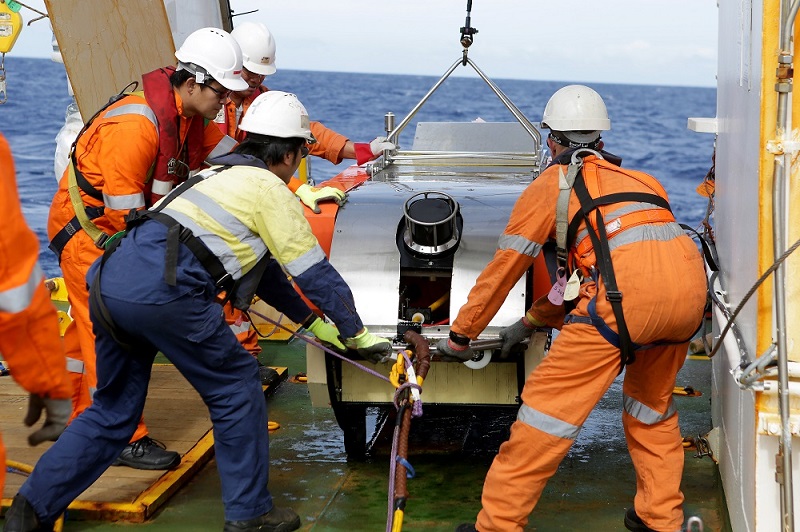
The Australian Transport Safety Bureau Tuesday officially completed its search for missing Malaysia Airlines flight MH370 with a massive 440-page report detailing the extraordinary lengths taken by investigators and scientists to find the missing Boeing 777-200ER.
In what will prove a useful blueprint for future marine searches for missing aircraft, the report outlines how the searchers drew on international expertise to build on the few available facts to execute an unprecedented and highly sophisticated search.
It details how they identified the search area, investigated end-of-flight scenarios and conducted the search for the plane after it mysteriously disappeared on March 8, 2014 with 239 people on board.
The $A198m joint effort between Australia, China and Malaysia failed to find the missing plane in the original 120,000 sq, km search area and the governments decided it should be suspended just as new information from drift analyses suggested a revised 25,000 sq, km likely crash site.
A closer analysis of satellite images from 2014 has since pinpointed a more precise area within the 25,000 sq, kms as likely containing the wreckage.
The Malaysian Government is now considering offers from at least two companies — including a no-find, no-fee offer from US-based Ocean Infinity — to resume the search into the new area.
ATSB personnel are keen to see the search resumed but say the incident has already produced some important lessons about locating missing aircraft in deep oceans.
The mystery also led to moves by international authorities to boost aircraft tracking, increase requirements for cockpit voice and flight data recorders and improve underwater locator beacons.
Investigators have also suggested consideration be given to installing automatically-deployed, floating search aids such as streamers or radar reflectors.
“This was an unprecedented endeavour and there has been an extraordinary response from the global community,” said ATSB chief commissioner Greg Hood, who praised the dedication of those involved. “There were contributions of expertise and resources from private business and organisations, agencies from different Governments, and from private individuals.”
Hood said the deepest sympathies remained those who lost loved ones on MH370.
The report does not contain any earth-shatteringly new conclusions but highlights how, despite criticism from some quarters, the searchers canvassed a wide range of scenarios.
For example, Australian investigators were sufficiently struck by the similarities between data recovered on the home flight simulator of MH 370 Captain Zaharie Ahmad Shah and the path of the doomed flight to look closely at whether there was a controlled ditching of the plane.
The flight simulator data was provided to the Australian Transport Safety Bureau in April, 2014, and had four complete and two partial data captures of simulations involving a Boeing 777-200LR.
Victor Iannello, of the independent experts group, noted on his blog that this was the first time the home simulator data was discussed in an official report and that it did not match the MH370 flight paths reconstructed from satellite data.
Six weeks before the accident flight, Zaharie had used his simulator to fly a route, initially similar to part of the route flown by MH370 up the Strait of Malacca, with a left-hand turn and track into the southern Indian Ocean.
“There were enough similarities to the flight path of MH370 for the ATSB to carefully consider the possible implications for the underwater search area,’’ the report said. “These considerations included the impact on the search area if the aircraft had been either glided after fuel exhaustion or ditched under power prior to fuel exhaustion with active control of the aircraft from the cockpit.”
The report said the possibility of a controlled ditching was carefully considered. A B777 could theoretically achieve a glide ratio of about 17:1, meaning it could travel 2.8 nautical miles for every 1000 ft of altitude lost. This meant a plane at 40,000ft at the point of fuel exhaustion could be glided from more than 100 nautical miles (185kms).
An event which interrupted the power supply to a satellite data unit was seen by investigators as most likely to be the result of fuel exhaustion but they also considered the less likely possibility of human intervention.
The investigators looked at both a controlled ditching and an unpowered glide and mapped out potential search areas.
But by June 2016, pieces of debris confirmed or deemed very likely to be from MH370 had been found, including some from within the fuselage.
“While no firm conclusions could be drawn given the limited amount of debris, the type, size and origin on the aircraft of these items generally indicated that there was a significant amount of energy at the time the aircraft impacted the water, not consistent with a successful controlled ditching,’’ the report said.
“Critically, a section of right outboard main flap was found near Tanzania on 20 June 2016. The item was shipped to the ATSB for analysis. This analysis indicated that the flaps were most likely in a retracted position at the time they separated from the aircraft making a controlled ditching scenario very unlikely.”
The update on the flap analysis included work by Defence, Science and Technology Group scientists that quantified a range of descent rates using data from the final two satellite transmissions from the aircraft. These concluded the aircraft was descending at a rate of between 2,900 ft per minute and 15,200 ft per minute min when the 7th arc was crossed and at between 13,800 ft per minute and 25,300 ft per minute eight seconds later. A normal descent rate is about 2000 ft per minute.
“These rates of descent ruled out a controlled unpowered glide with the intent to extend range,’’ the report concluded.























